|
| |
Home
 Ondas del Lago
Ondas del Lago
 Historic Photos
Historic Photos
|
This page consists
of old photos, postcards, & a few slideshows of Maracaibo, other oil
camp cities around Lake Maracaibo & eastern Venezuela, & Caracas
that have been found or contributed by former and present residents
of Venezuela.
Seeing them allows
us to compare these views with the way these landmarks may look
today or, in some cases, record for history those areas that, due to
changing time, circumstances, or politics, may no longer exist
today. |
A Hotel
del Lago postcard,
and the message written on
its flip side, taken and
mailed in 1958. This photo
was taken before the
addition of the Salon
Caroní at the front
right of the hotel.
Now....compare this
image of the hotel to the
photos below it and see the
striking difference that 50
years can make!
I do admit to
looking back somewhat
nostalgically from time to
time at the old layout of
the hotel and its
surroundings. But I suppose
the only sure thing in life
is change.
|
| |
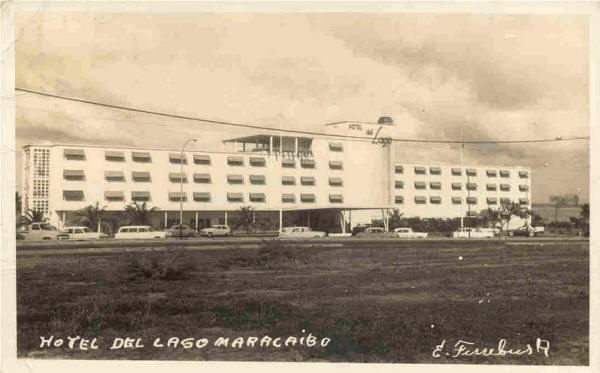
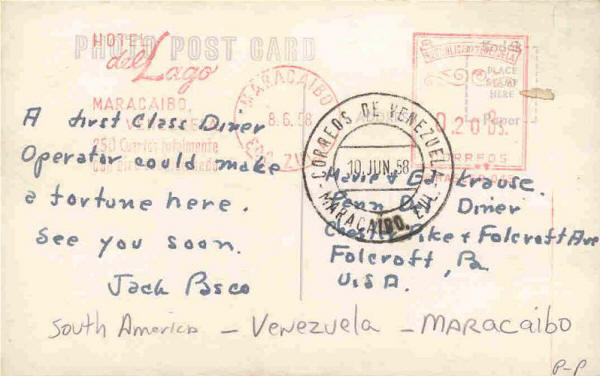
|
|
I found both of
these recent images of the Hotel
del Lago through photo
links on Google Map.
I'm really astounded by both
of them and the changes that
have taken place over the
years that they show.
The first image is
an amazing recent aerial
view of the hotel that
clearly shows the hotel
grounds as well as the
dramatic changes in the
hotel surroundings. Two
highrises immediately across
from the hotel on Av.
Milagro, where nice homes
once used to stand, now look
over the hotel grounds, with
a third one going up between
them. The Lago Mall beside
the hotel to its north,
where the Mene Grande camp
used to be, occupies square
footage at least as large as
that of the hotel, if not
larger. Also note the tennis
courts to the south of the
hotel, which I'm not sure if
they are a part of the hotel
or a part of Club
Náutico. I could go on
and on, but the photo speaks
for itself.
I've left the
enlargement link full-sized
so that one can browse the
image in detail. It's a far
cry today compared to the
past when the hotel
unquestionably dominated the
area around it for so many
years, when it was the
center of most major
Maracaibo events. If it was
held at the Hotel del
Lago, one knew it was big.
The over-exposed
photo below it shows that
they've apparently converted
the Salon Caroní into
a casino (!) - the Casino
del Lago. That too is a
far cry from the days when
the room was used for some
of our larger junior &
senior high school proms &
parties and the plays put on
by the Maracaibo Players.
|
| |
|
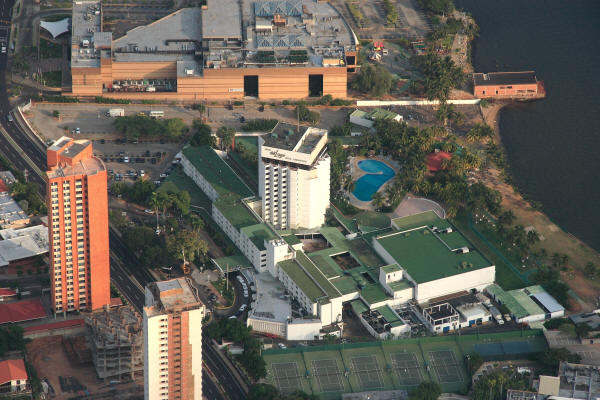
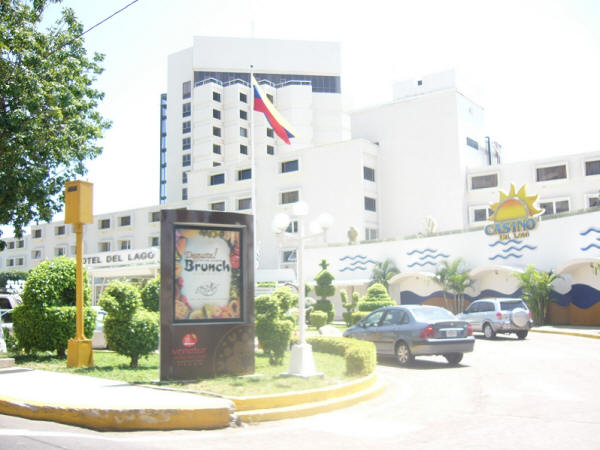
|
|
This is a photo of
the Pan
American harbor
and elegant passenger
terminal on Lake Maracaibo
taken in the early 1930's,
when Pan Am was
still using its flying
boats.
|
| |
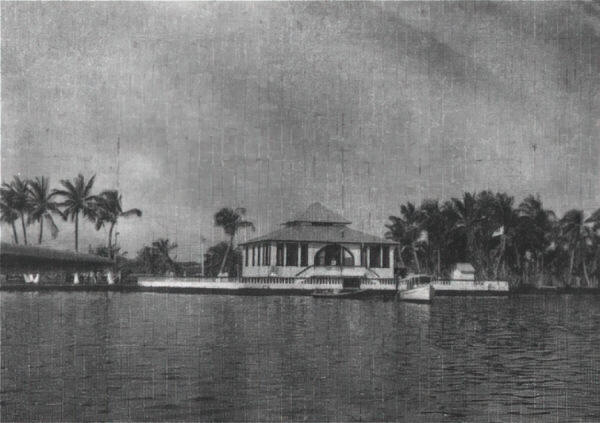
|
|
|
This Hotel del Lago brochure
was produced in 1962. This is the Hotel
del Lago exactly as I remember it,
before the advent of the multi-story
“big tower” with the additional rooms,
the extension of area where the old
restaurant was previously located for
the addition of new meeting rooms (which
eliminated the old swimming pool shown
in this brochure, which had the
underwater windows in the basement), and
the incorporation of the new,
considerably larger swimming pool.
The aerial photo shown really lays out
the whole area of the hotel as it was
back then really nicely.
|
| |
|
|
This postcard, sent from Maracaibo to
Germany, is postmarked June 24, 1908. It
translates from German as follows:
“Dear
Ms Buchwald! I
send you kind greetings from a long
distance. I would have enjoyed telling
you farewell, however you weren't
present.
“It is very nice in Maracaibo, only
very warm. Hopefully you feel quite good
and also my loves. I intend to stay here
for 2 years. Again yours sincerely, your
Anna Pabst.”
Below
these two postcard images you'll find
another one. The scene in this postcard,
in color this time, is taken from almost
exactly the same spot, but this time
reportedly in the 1920's. Doesn't look
like much has changed except for a new
streetlight and what appear to be
telephone poles, so the street appears
to have been electrified & perhaps
“telephonized” in the interim between
the two postcard photos.
|
| |
|
|
I'd
been told that the following photo dated to
about 1908 and that it was the 10th photo in
a series of images of Maracaibo (the
whereabouts of the other [at least] 9 images
is unknown). As one can see, it's an old
tram, and the image has been hand-colored
although much of the coloring, except for
the purple-red trolley, has faded over time.
I had assumed that the tram might be
electric-powered because of the street light
that's visible.
However, in March of 2008, I found an
excellent & informative website that fully
describes the history of the tram system in
Maracaibo. Entitled “The
Tramways of Maracaibo” by
Allen Morrison, this same image was found in
landscape format, which I've placed
immediately below this one. It indicates
that this photo was taken sometime before
1891, prior to the arrival of steam-powered
and later, electric-powered trams.
This
being the case, the tram in the photo was
very likely of the type shown in the last
image - the exact same kind of tram that
was located on the grounds of the Hotel del
Lago that we were all so familiar with.
|
| |
|
|
This section is not just limited to
images from Maracaibo, and this is a
good example of that. All of them were
taken in the 1920's.
Of these four (4) great panoramic
photos, three (3) of them are of the La
Salina camp. Two (2) show great
views of some of the camp housing and
the 3rd shows a photo of the pipe
storage yard that was located there.
The 4th photo is a fabulous open-water
port view of Maracaibo. Smoke from the
stacks of the old coal-burning ships in
movement are clearly visible as are a
few sailed fishing boats as well.
I aquired these from a dealer. The
enlargments you get when you click on
them are full-sized at high resolution
to allow you to see the images in
greater detail.
Steve Sleightholm, being more familiar
with the La Salina area than I
am, has reviewed the photos & provided
the descriptions.
|
| |
|
|
|
This image of La Salina during
the 1920's was taken from the road on
the Lagoon side of the original La
Salina Lago Petroleum Camp depicting
the management family housing. It is at
the south end of the camp. Notice the
small building immediately to the left
of the home in the foreground with side
walks leading to it. It is a Laundry
Building as back then the homes did not
containing washing machines or built-in
facilities for washing clothes..
|
|
|
|
This image shows the offices on the left
side of the photo and the
bachelor/worker family barracks style
housing. This picture was taken from the
Lake Shore side of the camp down near
the docks.
|
|
|
|
This is an image of the pipe storage
yard. You can see pipe used both for
drilling and pipeline. In addition this
area stores a large variety of supplies
used in production. You can also see the
rail tracks that are used to transport
supplies to and from the docks. In the
background to the right you can see the
elevated water supply tank and the oil
storage tanks. The Camp is to the far
right out of the picture..
|
|
|
|
A
wonderful 1920's open-water view of
ships in the port of Maracaibo.
|
|
|
|
This postcard, probably taken sometime
in the late early 1970's, shows three
good views of Maracaibo, including a
nice aerial shot of the Hotel del
Lago. Also shown is the Plaza
Baralt and a "general view" low
oblique angle aerial shot.
|
| |
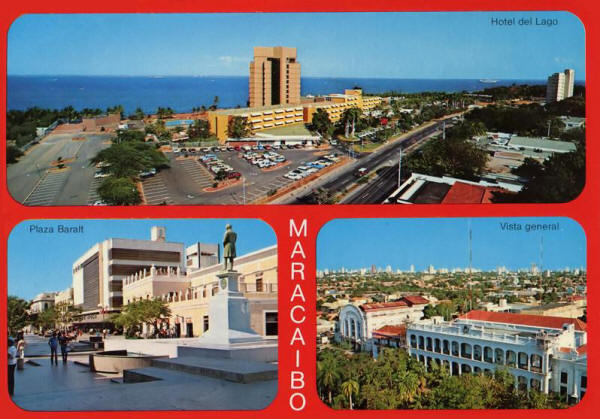
|
|
These photos of Christ Church were
taken by my father in early 1977. Even
at that time, changes within the city
were visible as witnessed by the tall
high-rises around the church that
appeared even then. I realize that this
is called “progress”, but it's a bit of
a shame the way the surroundings mar the
original outline of the church against
the horizon from the way it used to
appear.
But the church still retains it's
appealing & attractive lines. Four palm
trees (of the six originally planted
when the church was first built in the
1930's) on the property parallel to the
street were still there back in the late
'70's.
It would be nice to see how the church
and the propety look today.
The real reason I wanted to
post these photos, however, is because
they show the interior of the church. I
spent many hours in this church as we
went to services every Sunday “sin falta”.
At one time I was even an acolyte, and
my father was the volunteer treasurer of
the church for a number of years. We
used to stay later by about an hour or
so every Sunday after services had ended
while my father tallied the day's
offering.
I had always remembered the church as
being larger, but I suppose that's a
common phenomenon of memory. And I had
forgotten about the image in the stained
glass window in the front of the church
behind the altar until I saw these
photos again. It had been so familiar
to me back then after spending so many
hours looking at it during the sermons.
|
| |
|
|
This is another postcard that shows the Hotel
del Lago, taken in 1962. This was
the hotel as I pretty much knew it when
I lived in Maracaibo, before the pool
was moved & the multi-story addition was
added.
Below the postcard is the original
full-color, uncropped brochure page
photo from which the black-and-white
postcard was taken.
The pool was considerably smaller than
it is now, but it was always nicely
maintained. They always had a great
Sunday morning buffet brunch laid out in
the open-air area under the large
striped awning. We used to go there
after church, stop at Sweeney's
bookstore where my parents would get the
Sunday Miami Herald &
I'd pick up a copy of the latest MAD
Magazine or other magazine. Usually
we'd then go home, but often we'd go to
the buffet, eat all the great food (and
in those years, never gain weight!) and
spend the rest of the day by the pool.
I'd swim in the pool or even sometimes
go down & swim in the lake - it wasn't
polluted then as it is now. It was a
wonderful place to spend a relaxing
Sunday afternoon.
|
| |
|
|
|
“The
Hotel del Lago, (Maracaibo) Western
Venezuela's largest and most luxurious
hotel, 250 air-conditioned rooms,
situated on the banks of Lake
Maracaibo”.
|
|
|
|
These two postcards show Avenida 5 de
Julio in the El Paraíso area of
Maracaibo. Judging from the cars, they
were both taken in the late 1950's, and
my guess is they were both taken at
about the same time.
In the top image, Supermercado TODOS can
be seen on the left with Sears
Roebuck on the right. In the bottom
image in the opposing view, Sears
Roebuck is shown on the left with TODOS on
the right in the background.
|
| |
|
|
|
This absolutely wonderful photo of the Club
Los Andes taken in 1958 was
generously contributed by Tom Dickey.
It's a great shot of the club in its
early years and allows us to see what it
looked like close to when it ended its
life as a vessel & began its life as a
club.
Tom's father was a geologist with CREOLE in
Maracaibo between August 1958 & March
1970. They lived in the Creole Camp &
Tom attended EBV for all of 7th
& most of 8 grades.
|
| |
|
|
SLIDESHOWS
Over the years, I've received numerous Powerpoint presentations
through E-Mail that consist of numerous
old vintage photo slideshows of
Venezuela. Many of these are of the city
of Caracas, but are interesting in that
many of them show the city during
progressive, more stable, and perhaps
happier times, when Caracas was growing
by leaps & bounds and construction was
everywhere, fueled by petrolem revenues
- times when Caracas and Venezuela were
full of hope for the future. Others show
photos of buildings that were new when
the photo was taken but have since aged
& have been torn down. Some show
construction of the highways before they
became over-crowded. And others just
show interesting photos of the past.
There's
at least one presentation that shows
Venezuela as a whole, without a city
focus, but the shots are beautiful
indeed.
Those
without Powerpoint can't view
these presentations unless they were
saved with the viewer built-in (and most
weren't). Since buying Powerpoint isn't
cheap if you don't already own it, I've
converted them all to FLASH
presentations so that they can be viewed
with the Macromedia FLASH
viewer that's available for free and
can be downloaded as a browser plug-in.
The conversions come with player
controls along the bottom of each
presentation which allows one to stop
any photo at will for a closer view and
then continue on with the automatic
slideshow, or it even allows for manual
progression instead of automatic
progression through the slideshow if one
prefers.
In any
event, all of them have historical
value, and so I'm presenting them here,
all in one place. Please be patient to
allow them time to load, particularly on
slower connections.
|
|
|
|
|
|
“AYER”: This
slideshow shows scenes of Caracas during the 1920's
through the 1950's - [5.9 MB].
|
“CARACAS DE AYER ”:
As the name suggests, this slideshow also consists
of scenes of Caracas during the 1920's, '30's. &
'40's - [9.2 MB].
|
| |
|
|
|
|
|
“CONOCIENDO VENEZUELA ”: The
scenes in this slideshow are fairly current ones and
show some of the beautiful views of Venezuela - [1.3
MB].
|
“NUEVAS IMÁGENES ”: Popular
entertainment figures of the early 1960's mixed with
other photos of the times & earlier. And who could
forget Renny Otolina & the Twins? - [4.6
MB].
|
|
|
|
|
“HELICOIDE ”: This
slideshow is about the construction of the Helicoide
in Caracas -
[5.7 MB].
|
“VENEZUELA AÑOS 50's ”: The
construction of Hotel Avila is the focus of
this presentation -
[3.1 MB].
|
|
|
|
|
“TRATE DE RECORDAR ”: Try
to remember where these scenes in Caracas used to be
- [2.1 MB]. Advance the
views in this one manually with the controls on the
bottom.
|
“LA MEMÓRIA”: This
one is a memory game about old scenes in Caracas.
I've left it in Powerpoint format to
preserve the music -
[1.6 MB]. Please give
it enough time to download.
|
|
These vintage photographs of Maracaibo were
very generously contributed by Pedro López,
of Documentación Activa, Instituto de
Investigaciones, Facultad de Arquitectura y
Diseño, Universidad del Zúlia, in
Maracaibo. They're a priceless historical record of
Maracaibo and some of it's architecture as many of
us may have once remembered it.
It's reassuring to
know that old images of this kind from Maracaibo's
past are being saved & preserved at the Universidad
del Zúlia. A special thanks to Pedro for
allowing us to share these photos here.
|
|
|
|
Avenida 5 de Julio / SEARS, late 1950's
judging from the autos - Jacqueline
Alcal Collection.
|
Avenida 5 de Julio at the intersection
of Avenida Bella Vista, 1959.
|
|
|
|
|
Cerveceria Regional, date
unknown - Jacqueline Alcal Collection. I
knew Mr. Fred Gerhardt who managed this
brewery in the '60's, and our class took
a tour of this building.
|
Edifício 5 de Julio on Avenida
5 de Julio, date unknown.
|
|
|
|
Edifício Zúlia
Motors on Avenida Bella Vista, late
1950's judging from the autos.
|
“Petrolera”
- Beautiful example of an oil-company-
designed house on Avenida 3D. High
ceilings & the vents visible above the
windows maximize air cooling, as does
the reflective metal roof. According to
Pedro, this home still exists in a
wonderfully preserved state thanks to
the efforts of preservation groups (such
as FUNDAPATRIMÓNIO) in
Maracaibo today, and is one of the few
remaining examples built by the oil
companies at the beginning of the 20th
Century in Maracaibo.
|
|
|
|
|
Christ Church - date unknown, but taken
sometime in the 1930's judging from the
autos. Christ Church was established in
the mid-1920s by a group of British
Shell Oil Co. employees. (Photo
originally taken by the Kauffman
family.)
|
Christ Church - date unknown. (Image
originally provided by the Kauffman
family.)
|
|
|
|
|
Creole Camp & Club taken in 1972.
|
(Click above for higher resolution
enlargement)
|
|
|
|
Spectacular aerial view of the El
Saladillo area of Maracaibo looking
towards the Puente General Rafael
Urdaneta bridge in the distant
background. Date of the photo is 1962 - Pedro
López Collection.
|
|
(Enlargement
is large - high-speed connection is
recommended)
|
|
|
These postcards are of the La Salina area
and were part of a group of postcards I
recently acquired. There was only one
other postcard included in the group,
and it's not shown here. This postcard
was of the original EBV school
building, and it's shown in the Doug
Becker Historical Section (the
2nd photo).
Judging from that one EBV building
postcard that was included in the group,
the fact that the EBV building
is marked with the name of the school
and knowing the approximate age of the
similar photo shown above it, and
assuming that all postcards were
acquired roughly during the same time
period, I'd estimate the age of these
postcards to have been produced sometime
in the mid-to-late 1940's.
It's
interesting to note that the backs of
each postcard were printed in English
rather than Spanish. I believe some
conclusions can be made based on this
curiosity. They're only guesses, of
course, but my assumptions about these
postcards are as follows:
|
• The postcard
photos were likely taken by
either a Creole
Petroleum photographer
or by a photographer under
contract to Creole;
|
|
• The postcards
were probably printed in the
United States and then
shipped down to Venezuela to
be sold. I say this because
of the English printing on
the back, the lack of a
printed scene description,
and the logo that appears
above the “Place Stamp Here”
box. My guess is that this
is the printer's logo, “EKC”.
The ending letter “C”
probably stands for the
English word “Company”. If
this had been the logo of a
Venezuelan printer, the
letter “C” for the Spanish
word “Compañia” would have
likely appeared as the first
letter of the logo rather
than the last;
|
|
• The majority of
the intended buyers of these
postcards would probably
have been Creole employees
or ex-pats of other foreign
companies in the area around
the time they were printed.
I believe Creole might
have produced these
postcards for the benefit of
its ex-pat employees to send
to relatives back home and
to friends so that they
would have a better idea of
what some of the sights in
Venezuela looked like and
what it was like to live in
Venezuela during those
years. They would have been
sold from retail businesses
in Venezuela, such as the Foto
Ferrebús Rincón shop
shown imprinted on the
“postcard album” envelope in
which these postcards were
stored. That name (“Ferrebus Fot.”)
also appears on the face of
each postcard at a 45° angle
on the bottom right of each
face, written in white ink
as was popular at that time.
This means that the
identifying descriptions of
each postcard photo were
added afterwards in
Venezuela to properly
identify each photo (as
they're not identified on
the back) and as a
promotional item by the
retail store that sold them.
|
|
|
|
|
|
View of edge of camp
at La Salina & oil well.
|
View of the Lake in
foreground & La Salina camp
with oil wells in the
background.
|
La Salina Club with
dance floor area, clubhouse,
& club restaurant.
|
|
|
|
|
|
View of La Salina
pool.
|
Another angle view
of the La Salina pool.
|
La Salina Clinic
|
|
|
|
|
Port view of La
Salina with oil well
platforms, loading/unloading
area & tanker.
|
Sunset view of oil
wells - Cabimas.
|
|
|
|
|
“Postcard album” envelope in
which the postcards were
kept. It's (very) slightly
larger in size than the
postcards that were kept in
it. Opposite side had “La
Salina” lighlty handwritten
on it.
|
The backs of every postcard
looked like this. Brown
edges, which are glued on,
are probably remnants of the
way these photos were once
attached in an album.
|
|
|
|
|
Three of these photographs of Maracaibo
were taken during the 1920's, all having
an “AZO” 1920's postcard stamp
box on the reverse. The date for the
photo of the Liceo Baralt is
undetermined.
|
| |
|
|
|
|
Liceo Baralt
|
Edifício “El Paraíso”
|
|
|
|
|
Low oblique aerial photo of Maracaibo.
In terms of today's skyline, it's
interesting to note how low the skyline
used to appear, with few buildings -
except for the church on the horizon -
over two stories.
|
A
caimán placed on a fountain wall at
Plaza Bolívar.
|
|
|
This is a photo that was recently
discovered by Oster Bayne (see
below for more information about Oster)
that came from his father's collection.
Taken in 1950, it's an aerial shot of
the Maracaibo harbor with the CREOLE Marine
Offices and jetty in the foreground at
about the 4 to 5 o'clock position, and
the city in the background.
It's one of those historically priceless
photographs that has survived over half
a century, and has fortunately been
preserved by Oster's father to now be
shared here by all of us.
|
|
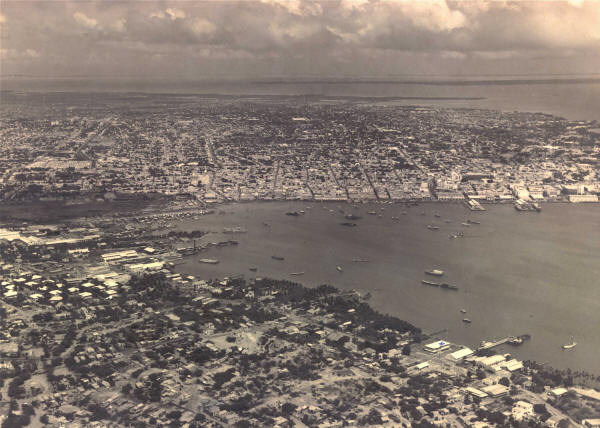
|
|
|
|
This photo is an old postcard of the Hotel
del Lago taken in 1958.
The photographer took the photo while
standing in what were once open fields across from
the hotel, well back from what appears to be a
narrow Av. Milagro standing in front of
the hotel - note the street
light that's visible center-right, which is
difficult to see.
|
Another old postcard
of the Hotel del Lago. Judging from the
size of the trees, which are pretty much similar in
size to the previous postcard, as well as the cars,
I'd guess that it was taken at roughly the same time
- the mid to late 50's.
It's also interesting
to note that, in both photos, the paint used on the
word "Lago" seems to have been of poor
quality because it appears to have stained the wall
behind it and run all the way down the wall as it
weathered. This was later corrected.
|
|
|
|
This is an early view of the Hotel
del Lago shortly after it was
built. The grass, which doesn't yet
reach the lake shoreline, is spotty &
clumpy, and the Club Náutico next
door has yet to be built as the club it
later became.
|
|
|
|
|
This is a
view that looks south at the old main CREOLE office
complex and the water tower behind it. Judging from
the cars that can be seen, my guess is that this is
a shot taken sometime after the mid-1940's (note the
JEEP). This is a ground view of the building which
is prominently seen here in
an earlier aerial view. The 3rd floor had not yet
been added to the building. I don't believe this
building exists anymore, but if anyone knows
differently, please correct me.
|
This is
another view of the old CREOLE office
complex taken from the upper floor of the building
and looking due east towards the lake, visible in
the far background. It was likely taken at about the
same time as the photo on the left. Doug Becker has
helped me identify some of the features. This shot
provides a view of some of the buildings that
surrounded the complex, including the garage on the
right, the Geology Lab just to the left of and
behind the garage, and the Bachelor Quarters on the
left above the bus.
|
|
|
This is a
photo of the trellis that used to exist over the
shallow end of the Creole Club pool. It's
difficult to date this photo as we know, from photos
Doug Becker has provided to this website on this page,
that this trellis existed as early as 1942 through
at least 1951. So this photo could have been taken
any time during this time period.
A curious
thing about this shot is the pool water level - it
almost appears that the pool was in the process of
being filled when this photo was taken.
|
|
|
|
|
Many of us
passed through Grano de Oro countless times
during the years we lived there, yet seldom does one
ever see a full-view photo of it. Seeing it was
always exciting because it either meant that we were
on our way home to the States on home leave, coming
back from home leave, going somewhere else on
vacation, or going to greet a friend or relative
coming to visit that we hadn't seen in a long time.
|
| |
|
Grano de
Oro was finally closed when they opened the
new La Chinita international airport, and
the property was given to the Universidad de
Zulia. Much has changed. The old terminal
building is now the Facultad de Ciencias,
and I understand that the area around the building
appears to be considerably run down. The whole area
around the old airport is now known as the "Sector
Grano de Oro" neighborhood. How something so
familiar & once so central to our lives - evocative
of so may emotions for us - could change so
dramatically or disappear so quickly is indeed sad.
|
|
|
|
This photo is a postcard shot of the old Grano
de Oro international airport taken sometime in
the early 1950's, judging from the cars in the
photo.
The area below the terrace is where we all
used to wait for inbound passengers. We could see
them through the glass as they went through
immigration & customs, and it was always a lot of
fun to see who else came in on the same flight the
person you were waiting for flew in on. It was
always particularly exciting around Christmas time
when everyone would fly back to Maracaibo for the
holidays
|
This is another old postcard of Grano de Oro.
The date of this postcard is unknown, but judging from
the truck in the photo, my guess would be that it was
taken sometime in the late '50's or early 60's. The
airport looks pretty new in this photo.
Passengers used to debark into the midsection,
and baggage used to go in to customs through the doors
on the right. The restaurant & large open terrace that
used to overlook the runways were below the control
tower. It was really a nice & open terminal design for
flying in that era. Flying today may be cheaper, but the
ease, relaxation, & service of flying in the early '60's
- when it was still something special - disappeared
years ago & is something I'll miss forever.
|
|
|
|
This is a postcard of the airport that
replaced the old Grano de Oro airport,
called "La Chinita", named
after the Virgen de Chiquinquirá.
Located farther out of town, there's
plenty of space for future expansion,
which was the main problem facing Grano
de Oro, and was the reason for the
construction of this new airport.
|
|
|
|
